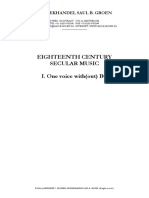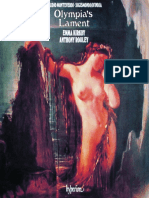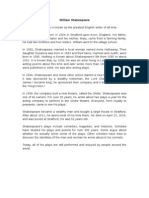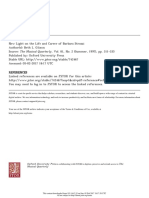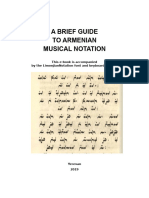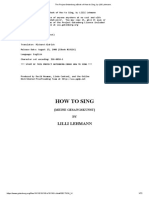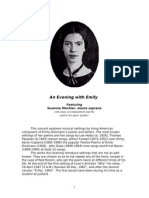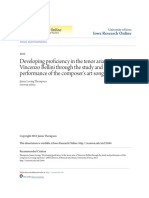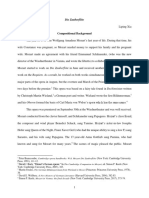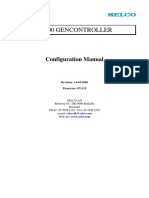0 ratings0% found this document useful (0 votes)
82 viewsArt Song Presentation
Art Song Presentation
Uploaded by
Timothy Tavita23An art song is a musical setting of a poem, usually for solo voice and piano. The German Lied tradition is prominent, with composers like Schubert, Brahms, and Wolf writing over 600 songs between them. In France, accompanied vocal pieces are called mélodies, while in England they are called art songs. Well-realized art songs achieve a balance between the music and poetry, with the piano enhancing the meaning of the text. Key composers of this genre include Schubert, Brahms, Fauré, and English composers like Purcell.
Copyright:
© All Rights Reserved
Available Formats
Download as PPT, PDF, TXT or read online from Scribd
Art Song Presentation
Art Song Presentation
Uploaded by
Timothy Tavita230 ratings0% found this document useful (0 votes)
82 views28 pagesAn art song is a musical setting of a poem, usually for solo voice and piano. The German Lied tradition is prominent, with composers like Schubert, Brahms, and Wolf writing over 600 songs between them. In France, accompanied vocal pieces are called mélodies, while in England they are called art songs. Well-realized art songs achieve a balance between the music and poetry, with the piano enhancing the meaning of the text. Key composers of this genre include Schubert, Brahms, Fauré, and English composers like Purcell.
Original Title
Art song presentation
Copyright
© © All Rights Reserved
Available Formats
PPT, PDF, TXT or read online from Scribd
Share this document
Did you find this document useful?
Is this content inappropriate?
An art song is a musical setting of a poem, usually for solo voice and piano. The German Lied tradition is prominent, with composers like Schubert, Brahms, and Wolf writing over 600 songs between them. In France, accompanied vocal pieces are called mélodies, while in England they are called art songs. Well-realized art songs achieve a balance between the music and poetry, with the piano enhancing the meaning of the text. Key composers of this genre include Schubert, Brahms, Fauré, and English composers like Purcell.
Copyright:
© All Rights Reserved
Available Formats
Download as PPT, PDF, TXT or read online from Scribd
Download as ppt, pdf, or txt
0 ratings0% found this document useful (0 votes)
82 views28 pagesArt Song Presentation
Art Song Presentation
Uploaded by
Timothy Tavita23An art song is a musical setting of a poem, usually for solo voice and piano. The German Lied tradition is prominent, with composers like Schubert, Brahms, and Wolf writing over 600 songs between them. In France, accompanied vocal pieces are called mélodies, while in England they are called art songs. Well-realized art songs achieve a balance between the music and poetry, with the piano enhancing the meaning of the text. Key composers of this genre include Schubert, Brahms, Fauré, and English composers like Purcell.
Copyright:
© All Rights Reserved
Available Formats
Download as PPT, PDF, TXT or read online from Scribd
Download as ppt, pdf, or txt
You are on page 1of 28
Art Song
What is an Art Song?
- An Art song is the musical representation of a
poem.
• Art songs have been composed in many
languages, and are known by several names. The
German tradition of art song composition and is
perhaps the most prominent one; it is known
as Lieder. In France, the term Mélodie
distinguishes art songs from other French vocal
pieces referred to as chansons and their is English
art Songs.
• An art song may either be through-composed
(each stanza of the poem is sung to new music) or
strophic (all stanzas of the poem are sung to the
same music)
• A group of art songs that is conected by a musical
idea is called "Song cycle".
• Two things happened that paved the way for the
creation of the art song
-Popular German poets, Von Goethe and
Heine, wrote verses about love, the beauty of
nature and supernatural events.
-During the same time, the manufacturing of
pianos with an iron harp made for more
expressive instruments.
-As a result, composers discovered that they
could transform the poems into songs and
use the piano to enhance and intensify
their meaning
• In general, Art songs were short pieces, and while
many were suitable for amateurs to learn and sing
in at home, most were intended for trained artists
to perform in the concert hall.
• Art Song, like classical music, is essentially an
urban phenomenon, in some ways a lingering
product of an aristocratic society with origins in
the medieval courts, colleges, cities and churches.
• an art song strives to be the perfect combination
of music and literature, based on four elements:
poet, composer, singer and accompanist.
• In well-realized Art Song, the composer creates a
duet between the accompanist and the vocalist.
That is, the art song paints for us a picture of
what the poet might have envisioned. The
performance of an art song literally breathes life
into this picture through a complementary,
coordinated partnership among the four
significant elements.
Mélodie
A Mélodie is the accompanied art song of the 19th and 20th centuries.
The 19th century Mélodie was usually a setting of a serious lyric
poem for solo voice and piano that recognizably combined and
unified the poetic and musical forms.The Mélodie arose just before
the middle of the 19th century in France. The text of a mélodie was
more likely to be taken from contemporary, serious poetry and the
music was also generally of a more profound sort. Further, while
most composers in this genre were Romantics, at least in
chronology, certain features of mélodies have led many to view
them as not properly Romantic.
• Charles Gounod is often viewed as the first distinct composer
of mélodies: his compositional style evolves imperceptibly
and illustratively from romance to mélodie. He wrote over
200 mélodies, on texts by such poets as Victor Hugo and
Lamartine. His setting of Lord Byron's Maid of Athens, in
English, is a perfect example of a romance that has become a
mélodie. Though numerous other composers, such as
Massenet, wrote mélodies during Gounod's lifetime, a name
that cannot be omitted is that of Gabriel Fauré. He wrote over
100 mélodies and has been called the French Schumann,
though their styles and essential temperaments were very
different.
Lieder
Originally denoted in classical music the setting of Romantic German poems to
music, especially during the late eighteenth and nineteenth centuries.
Among English speakers,"Lied" is often used interchangeably with "art
song" to encompass works that the tradition has inspired in other
languages. The poems that have been made into Lieder often center on
pastoral themes or themes of romantic love.Typically, Lieder are arranged
for a single singer and piano, the Lied with orchestral accompaniment being
a later development in Germany, the great age of song came in the
nineteenth century. German and Austrian composers had written music for
voice with keyboard before this time, but it was with the flowering of German
literature in the Classical and Romantic eras that composers found
inspiration in poetry that sparked the genre known as the Lied.
Lieder
It was with Schubert that a new balance was found between words and music,
a new absorption into the music of the sense of the words. Schubert wrote
over 600 songs, some of them in sequences or song cycles that relate an
adventure of the soul rather than the body.The tradition was continued by
Schumann, Brahms, and Hugo Wolf, and on into the 20th century
by Strauss, Mahlerand Pfitzner. Partisans of atonal music, such as Arnold
Schoenberg and Anton Webern, composed Lieder in their own style.
English Art Song
the composition of art song in England and English-speaking countries has a
long history, beginning with lute song in the late 16th century and continuing
today.
17th century
The composition of polyphonic music was at its peak in the late 16th century.
By that time, however, the lute started to gain popularity, and was very
common among educated people by 1600. Giulio Caccini and the Florentine
Camerata developed the monody, for solo voice with lute accompaniment,
around 1600. Caccini traveled around Europe, other countries begin
developing their own solo songs with lute, especially the English
composers. John Dowland (1563–1626) and Thomas Campion (1567–1620)
emerged as the best-known and most respected of the composers of lute
song. Later in the 17th century, Henry Purcell (1659–95) composed many
solo songs for his semi-operas, and his songs are also generally considered
among the best early English Art songs.
English Art Song
18th century
George Frideric Handel (1685–1759) made Italian opera very popular in
London, but The Beggar's Opera in 1729, a parody of Handel's Italian
operas, created a new fad for English popular opera, and Italian opera in
London faded by 1740. Thus, the two important types of English solo vocal
music in the mid 18th century are oratorios by Handel, and "pastiche
operas" or "ballad operas" from Arne, Boyce and other English composers.
The publication of solo vocal music (songs often called "canzonets" or
canzonettas") with English texts at the end of the 18th century helped to
establish the art song genre in subsequent years. 20th century. The great
success of European Romantic composers encouraged a "Renaissance" of
English music, especially vocal music. Interest in British folk music was
expanded through the work of Cecil Sharp, Ralph Vaughan Williams and
others; it gradually becomes incorporated into British "classical" music.
English Art Song
20th century
The great success of European Romantic composers encouraged a
"Renaissance" of English music, especially vocal music. Interest in British
folk music was expanded through the work of Cecil Sharp, Ralph Vaughan
Williams and others; it gradually becomes incorporated into British
"classical" music
Key Composers
Franz Schubert
Born on January 31, 1797 in Himmelpfortgrund, Austria,died on November 19,
1828, in Vienna, Austria. Franz Peter Schubert demonstrated an early gift
for music. As a child, his talents included an ability
to play the piano, violin, organ and was also an excellent singer. Schubert is
regarded as the supreme melodist among the great composers. Many of his
melodies do sound effortless. They flow from his symphonies, string
quartets, sonatas, and other instrumental works from the music he wrote for
the stage. But his talent shone the brightest in his famous Lieder.Boosted by
a wealth of late 18th-
century lyric poetry and the development of the piano, Schubert tapped the
poetry of giants like Johann Wolfgang von Goethe, showing the world the
possibilty of representing their works in musical form. He wrote over 600 lieder,
many of which are still highly regarded today.
Gretchen am Spinnrade D 118 (1814)
"Gretchen at the Spinning Wheel"
Der Erlkönig D328 (1815)
"Elf King"
Serenade
Johannes Brahms
Widely considered one of the 19th century's greatest composers and one of
the leading musicians of the Romantic era, Johannes Brahms was born on May
7, 1833, in Hamburg, Germany and died on April 3, 1897, from
complications due to cancer.
His father was a double bassist in the Hamburg Philharmonic Society, and the
young Brahms began playing piano at the age of seven. By the time he was
a teenager, Brahms was already an accomplished musician, and he used
his talent to earn money at local inns, in brothels and along the city's docks
to ease his family's often tight financial conditions.
Brahms was introduced to the renowned German composer and music critic
Robert Schumann. The two men quickly grew close, with Schumann seeing
in his younger friend great hope for the future of music. Over the next
several years, Brahms held several different posts, including conductor of a
women's choir in Hamburg, which he was appointed to in 1859. He also
continued to write his own music. He wrote over 260 lieder, but is better
remembered for his symphonies and other works, succeeded Schumann.
Sonntag opt.47 No.3
Standchen
Robert Schumann
He was born June 8, 1810 in Germany and died on July 29,1856 in Germany.
He began his muical education at the age of six, studying the piano. Robert
Schumann's works are noted for its links to literature. Many of his
compositions allude to characters or scenes from poems, novels, and plays;
others are like musical crossword puzzles with key signatures or musical
themes that refer to people or places important to the composer. This
intimate relationship with the written word gives his music an extra
dimension. At the same time, its sheer joyfulness ranks it among the best
loved music of the age, He stands in the front rank of German Romantic
figures.
Dichterliebe ( Poet's Love)
Widmung op. 25
You might also like
- Base Materialism and GnosticismDocument5 pagesBase Materialism and GnosticismjjempNo ratings yet
- 18th Century Secular Music - One Voice With (Out) BCDocument105 pages18th Century Secular Music - One Voice With (Out) BCFelipe100% (1)
- Ma RendiDocument41 pagesMa RendiscribNo ratings yet
- Alban Berg - Sieben Fruhe Lieder Performance PerspDocument22 pagesAlban Berg - Sieben Fruhe Lieder Performance PerspccNo ratings yet
- First Publication 1664Document3 pagesFirst Publication 1664Hadi Beigli BaritoneNo ratings yet
- Vocal Ornamentation in The 18th Century - Tosi and Mancini, First Theorists of Bel CantoDocument12 pagesVocal Ornamentation in The 18th Century - Tosi and Mancini, First Theorists of Bel CantoEugen Igorewitsch Casimov-FrolkowNo ratings yet
- Song Lit CLASS NOTESDocument73 pagesSong Lit CLASS NOTESAllison WoolridgeNo ratings yet
- Booklet - Olympia's LamentDocument13 pagesBooklet - Olympia's LamentFelipeNo ratings yet
- Una Furtiva LagrimaDocument2 pagesUna Furtiva LagrimaAhmad SyabilNo ratings yet
- Die Schone MullerinDocument22 pagesDie Schone MullerinjclaphamNo ratings yet
- Blow Blow Thou Winter Wind by William ShakespeareDocument3 pagesBlow Blow Thou Winter Wind by William ShakespeareArri AmirNo ratings yet
- The Puccini Code: Turandot. They Work Toward Solving The Riddles of Puccini's TechDocument26 pagesThe Puccini Code: Turandot. They Work Toward Solving The Riddles of Puccini's TechBlanca Mallada AtarésNo ratings yet
- The Seventeenth Century Trillo: Historical Practice For The 21 ST Century SingerDocument100 pagesThe Seventeenth Century Trillo: Historical Practice For The 21 ST Century SingerShtonNo ratings yet
- What Are The Elements of MusicDocument4 pagesWhat Are The Elements of MusickrictsNo ratings yet
- Body Awareness Alignment Breath MechanismDocument11 pagesBody Awareness Alignment Breath MechanismcheshiecNo ratings yet
- The Use of Wienerisch in Der Rosenkavalier - A Dialect AnalysisDocument44 pagesThe Use of Wienerisch in Der Rosenkavalier - A Dialect AnalysisAnonymous CFFaYJNo ratings yet
- 2.09 La-Vendetta (Cor Donato)Document6 pages2.09 La-Vendetta (Cor Donato)Francesca BartoloNo ratings yet
- Curriculum Vitae - Lisa Lowry WebDocument12 pagesCurriculum Vitae - Lisa Lowry Webapi-258658569No ratings yet
- Barbara Strozzi GlixonDocument26 pagesBarbara Strozzi GlixonMiriam Bastos MarzalNo ratings yet
- The New Music Theater: Seeing The Voice, Hearing The Body: by Eric Salzman and Thomas DésiDocument10 pagesThe New Music Theater: Seeing The Voice, Hearing The Body: by Eric Salzman and Thomas DésiThays W. OliveiraNo ratings yet
- A Brief Guide To Armenian Musical NotatiDocument17 pagesA Brief Guide To Armenian Musical NotatiAvraam PapaioannouNo ratings yet
- Liszt - Tre Sonetti - Analisi Sonetto 47Document20 pagesLiszt - Tre Sonetti - Analisi Sonetto 47Marco MontellaNo ratings yet
- How To Sing - Lilli LehmannDocument72 pagesHow To Sing - Lilli Lehmannmariana-i974No ratings yet
- Booklet - Serpent and FireDocument58 pagesBooklet - Serpent and FireFelipeNo ratings yet
- Sumi Jo - WikipediaDocument12 pagesSumi Jo - WikipediasallyNo ratings yet
- The Changes in The Cultural and Social Meaning of Music - The Case of TikTokDocument85 pagesThe Changes in The Cultural and Social Meaning of Music - The Case of TikTokGracia PMNo ratings yet
- 5-8 Vocal Music MERGEDocument131 pages5-8 Vocal Music MERGEkosmos.operastudioNo ratings yet
- On Approaching The Music Theatre of BeatDocument9 pagesOn Approaching The Music Theatre of BeatAlionaNo ratings yet
- Arnold, Solo Mottett in VeniceDocument14 pagesArnold, Solo Mottett in VeniceEgidio Pozzi100% (1)
- In Search of The "True" Sound of An Artist: A Study of Recordings by Maria CallasDocument358 pagesIn Search of The "True" Sound of An Artist: A Study of Recordings by Maria CallasSidi Gabriel CarballoNo ratings yet
- Cazden - Realism in Abstract MusicDocument23 pagesCazden - Realism in Abstract MusicsantimusicNo ratings yet
- Song Analysis - Daybreak in AlabamaDocument2 pagesSong Analysis - Daybreak in AlabamacmewileontvNo ratings yet
- Vocal Ornaments in Durantes Arie Devote (1608)Document18 pagesVocal Ornaments in Durantes Arie Devote (1608)Javier MecozziNo ratings yet
- PastureagencydescDocument1 pagePastureagencydescapi-249701470No ratings yet
- 1aa3 9 PDFDocument15 pages1aa3 9 PDFRainie Jiang0% (1)
- The Art of Re Enchantment Making Early Music in The Modern Age Nick WilsonDocument314 pagesThe Art of Re Enchantment Making Early Music in The Modern Age Nick WilsonAltea GuevaraNo ratings yet
- An Evening With EmilyDocument16 pagesAn Evening With EmilyAshly Ann Welch100% (1)
- Resurrection From The Coffin: Voice Research and TechnologyDocument3 pagesResurrection From The Coffin: Voice Research and TechnologyMatias TomasettoNo ratings yet
- MUS 342 (Barone) Final Exam Study Guide - Fall 2016 Part 1. TerminologyDocument3 pagesMUS 342 (Barone) Final Exam Study Guide - Fall 2016 Part 1. TerminologyKevin Paul TumbagahanNo ratings yet
- Susan McClaryDocument7 pagesSusan McClaryjames823838a100% (2)
- Die Fliegende Holländer - Overture AnalysisDocument34 pagesDie Fliegende Holländer - Overture AnalysisIsraelEsparzaLópezNo ratings yet
- Vicenzo Bellini-Documental PDFDocument110 pagesVicenzo Bellini-Documental PDFTDROCKNo ratings yet
- Opera Review FinalDocument3 pagesOpera Review Finalapi-252342353No ratings yet
- Women in Music_ an Anthology of Source Readings From the Middle Ages to the Present -- Neuls-Bates, Carol -- 1996 -- Boston_ Northeastern University Press -- 9781555532406 -- c83ba464cea6861ffe537856262cfd4b -- Anna’s ArchiveDocument426 pagesWomen in Music_ an Anthology of Source Readings From the Middle Ages to the Present -- Neuls-Bates, Carol -- 1996 -- Boston_ Northeastern University Press -- 9781555532406 -- c83ba464cea6861ffe537856262cfd4b -- Anna’s ArchivejewlisabossNo ratings yet
- Worksheet: Name: - DateDocument7 pagesWorksheet: Name: - Datethemu5icroomNo ratings yet
- Pathological Voice Duprez PDFDocument22 pagesPathological Voice Duprez PDFPaulaRiveroNo ratings yet
- Effects of Melody and Technique On Acoustical and Musical Features of Western Operatic Singing VoicesDocument9 pagesEffects of Melody and Technique On Acoustical and Musical Features of Western Operatic Singing Voicesaku sagitaNo ratings yet
- Hoch 2018Document19 pagesHoch 2018Ana Luisa Vargas100% (2)
- A Poetic and Musical Analysis of Fiancailles Pour Rire by FrancisDocument49 pagesA Poetic and Musical Analysis of Fiancailles Pour Rire by FrancisHéloïseNo ratings yet
- Franco CorelliDocument14 pagesFranco Corellimgarevalo10No ratings yet
- Brahms Wie Melodien 842895Document56 pagesBrahms Wie Melodien 842895hellosusiederkinsNo ratings yet
- Alessandro Scarlatti and The CantataDocument9 pagesAlessandro Scarlatti and The CantataRachael ByrneNo ratings yet
- Webern, Schoenberg, and The Original Version of "Himmelfahrt"Document5 pagesWebern, Schoenberg, and The Original Version of "Himmelfahrt"CarlosNo ratings yet
- 05 - A Brief History of OperaDocument3 pages05 - A Brief History of OperaSebastianBirch100% (1)
- RepertoireDocument3 pagesRepertoireapi-263797281No ratings yet
- Vocal ProgramDocument10 pagesVocal ProgramKhaya PaladaNo ratings yet
- 19th Century Opera As Popular ArtDocument2 pages19th Century Opera As Popular ArtVeronica McMurrayNo ratings yet
- Liping Die Zauberflöte PaperDocument11 pagesLiping Die Zauberflöte PaperLiping XiaNo ratings yet
- Women in World MusicDocument16 pagesWomen in World Musicnieto103100% (1)
- K366 Idomeneo For PDFDocument63 pagesK366 Idomeneo For PDFGerard Pablo0% (1)
- The Opera: A Sketch of the Development of Opera. With full Descriptions of all Works in the Modern RepertoryFrom EverandThe Opera: A Sketch of the Development of Opera. With full Descriptions of all Works in the Modern RepertoryNo ratings yet
- SLG SocSci5 1.2 History and Evolution of MoneyDocument6 pagesSLG SocSci5 1.2 History and Evolution of MoneyTimothy Tavita23No ratings yet
- SLG SocSci5 1.1 Functions of MoneyDocument7 pagesSLG SocSci5 1.1 Functions of MoneyTimothy Tavita23No ratings yet
- SLG Math5 6.3.1 Increasing and Decreasing Functions and The First Derivative Test Part 1Document7 pagesSLG Math5 6.3.1 Increasing and Decreasing Functions and The First Derivative Test Part 1Timothy Tavita23No ratings yet
- SLG Math5 6.3.2 Increasing and Decreasing Functions and The First Derivative Test Part 2Document5 pagesSLG Math5 6.3.2 Increasing and Decreasing Functions and The First Derivative Test Part 2Timothy Tavita23No ratings yet
- SLG Math5 6.2.1 Extrema of Functions Part 1Document8 pagesSLG Math5 6.2.1 Extrema of Functions Part 1Timothy Tavita23No ratings yet
- Lesson PlanDocument4 pagesLesson PlanAnimor-nocahc070824No ratings yet
- ApologyDocument12 pagesApologykhushnood aliNo ratings yet
- Types of CryptarithmsDocument3 pagesTypes of CryptarithmsKushal raj50% (4)
- 04 DPF Simple ExtensibilityDocument53 pages04 DPF Simple ExtensibilityVamaNo ratings yet
- IOE Embedded SyllabusDocument3 pagesIOE Embedded Syllabus078msdsa001.baikunthaNo ratings yet
- MahabharataDocument35 pagesMahabharataarorakrishika491No ratings yet
- Đề Thi Đề Xuất Phú Riềng 18-19Document7 pagesĐề Thi Đề Xuất Phú Riềng 18-19Nguyễn Thu GiangNo ratings yet
- LDRDocument166 pagesLDRJavierNo ratings yet
- Math I Week 1 IIQDocument16 pagesMath I Week 1 IIQZairah Lyn SaysonNo ratings yet
- Universal Grammar Approaches: in First Language AcquisitionDocument6 pagesUniversal Grammar Approaches: in First Language AcquisitionMark Vincent Z. PadillaNo ratings yet
- A Prayer For Those Who Are Preparing Children For Their First Holy CommunionDocument3 pagesA Prayer For Those Who Are Preparing Children For Their First Holy CommunionArmel CollantesNo ratings yet
- Selco-C6200 Configuration-Manual en 2017Document49 pagesSelco-C6200 Configuration-Manual en 2017mohsin100% (1)
- HTML and Web NotesDocument75 pagesHTML and Web Noteskumaresan palanisamyNo ratings yet
- Concessive ClauseDocument6 pagesConcessive ClauseCMarie Cachero PazNo ratings yet
- The Art of Gratitude - Quranic Themes On ShukrDocument31 pagesThe Art of Gratitude - Quranic Themes On Shukrjohnjosephjacob165No ratings yet
- English - Online (Lit F2)Document24 pagesEnglish - Online (Lit F2)Bryan Abdul AzizNo ratings yet
- Running Oracle EBS in The CloudDocument60 pagesRunning Oracle EBS in The Cloudrohit kumarNo ratings yet
- Odd and Even Numbers HomeworkDocument8 pagesOdd and Even Numbers Homeworkafmsuaddt100% (1)
- MYP Personal Project Guide SpanishDocument81 pagesMYP Personal Project Guide SpanishElizabeth ViernesNo ratings yet
- Rivera - TranspersonalDocument4 pagesRivera - TranspersonalJohn RiveraNo ratings yet
- Transformation A Quadrilateral To A Rectangle.: Solution 1.Document16 pagesTransformation A Quadrilateral To A Rectangle.: Solution 1.Aldo Juan Gil CrisóstomoNo ratings yet
- ( (Đề) G11 - U8Document3 pages( (Đề) G11 - U8Phan Khanh Huyen (FE School HPG)No ratings yet
- LogDocument5 pagesLogJames KurtzNo ratings yet
- 2024 - S1 - CFAF05D Study Guide v2Document27 pages2024 - S1 - CFAF05D Study Guide v2Monwa BisiNo ratings yet
- Alsa Driver APIDocument76 pagesAlsa Driver APIarchankumarturagaNo ratings yet
- 05 Complex NumbersDocument10 pages05 Complex Numbersthanvishetty2703No ratings yet
- Computersecuritystudent ComDocument48 pagesComputersecuritystudent ComSmx IES BadiaNo ratings yet
- Paper Title (Use Style: Paper Title) : Subtitle As Needed (Paper Subtitle)Document4 pagesPaper Title (Use Style: Paper Title) : Subtitle As Needed (Paper Subtitle)Agung SuryaputraNo ratings yet
- World Religion - JudaismDocument19 pagesWorld Religion - JudaismLancelot BaroqueNo ratings yet

